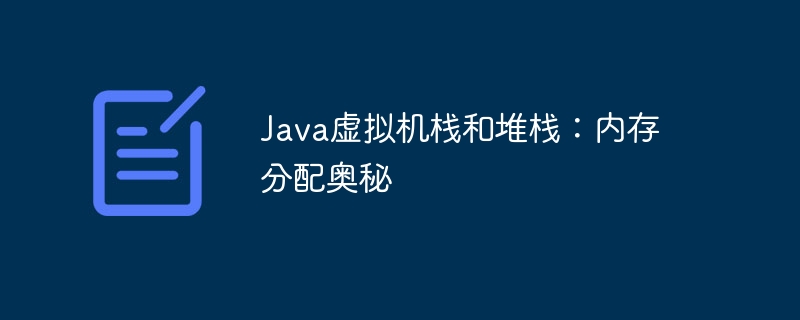Home >Java >javaTutorial >Java Virtual Machine Stacks and Stacks: Memory Allocation Mysteries
Java Virtual Machine Stacks and Stacks: Memory Allocation Mysteries
- 王林Original
- 2024-05-09 15:48:02620browse
The stack and stack are two key areas where the JVM stores data. The stack is used to store local variables, method calls, and return addresses, while the stack is used to store objects. The stack uses the LIFO strategy to allocate memory, and the stack allocates and reclaims memory based on the lifetime of the object. The JVM allocates memory in stacks and stacks based on the type of object. The stack stores basic data types and method calls, and the stack stores objects and arrays. Understanding the differences between these two areas is critical to optimizing the performance of Java applications, such as avoiding stack overflows, which occur due to excessive recursion or deeply nested method calls.

Java Virtual Machine Stack and Stack: Memory Allocation Mysteries
Introduction
Java Virtual Machine (JVM) uses two key areas of memory to store data: stack and heap. Understanding the differences between these two areas is critical to optimizing the performance of your Java applications.
Stack
The stack is a first-in, last-out (LIFO) data structure used to store local variables, method calls, and return addresses.
public class StackExample {
public static void main(String[] args) {
int a = 10; // 局部变量,存储在栈中
method1(); // 方法调用,将返回地址存储在栈中
}
public static void method1() {
int b = 20; // 局部变量,存储在栈中
}
}When entering the method1() method, a new stack frame will be created, which contains the method's local variables and return address. When the method returns, the stack frame is popped from the stack.
Stack
The stack is a dynamic data structure that allocates memory and is used to store objects. The stack allocates and deallocates memory based on the lifetime of the object.
public class HeapExample {
public static void main(String[] args) {
String s = new String("Hello"); // 创建对象,存储在堆栈中
s = null; // 将对象引用设置为 null,标记为垃圾回收
}
}After an object is created on the stack, the Java garbage collection mechanism will automatically recycle objects that are no longer referenced.
Memory Allocation
The JVM allocates memory on and off the stack based on the type of object.
- Stack: Basic data types (int, float), method calls and return addresses.
- Stack: Objects and arrays.
Practical Case: Stack Overflow
Stack overflow occurs when a stack frame exceeds its allocated size, usually due to excessive recursion or deeply nested method calls.
public class StackOverflowExample {
public static void main(String[] args) {
stackOverflow(0); // 递归方法,可能导致栈溢出
}
public static void stackOverflow(int i) {
stackOverflow(++i); // 自我递归调用
}
}Conclusion
Understanding stacks and stacks is crucial for performance optimization of Java applications. The stack is used to store local variables and method calls, while the stack is used to store objects. By understanding the differences between the two regions, you can optimize memory usage and avoid memory errors.
The above is the detailed content of Java Virtual Machine Stacks and Stacks: Memory Allocation Mysteries. For more information, please follow other related articles on the PHP Chinese website!

